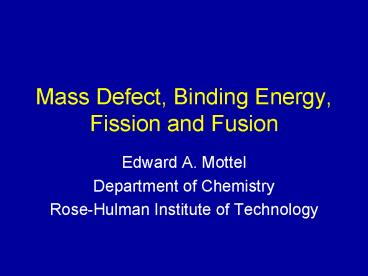Mass Defect, Binding Energy, Fission and Fusion - PowerPoint PPT Presentation
1 / 44
Title:
Mass Defect, Binding Energy, Fission and Fusion
Description:
... of Chemistry. Rose-Hulman Institute of Technology. Nuclear Energy. Mass ... The nuclear mass of 238U is 238.0003. Why does the Handbook of Chemistry and Physics ... – PowerPoint PPT presentation
Number of Views:2914
Avg rating:3.0/5.0
Title: Mass Defect, Binding Energy, Fission and Fusion
1
Mass Defect, Binding Energy, Fission and Fusion
- Edward A. Mottel
- Department of Chemistry
- Rose-Hulman Institute of Technology
2
Nuclear Energy
- Mass Defect
- Binding Energy
- Nuclear Fission
- Nuclear Fusion
- Comparisons of various forms of energy
3
Mass Defect
- The nucleus
- is composed of protons and neutrons
- the actual mass is less than the mass of the
separate particles. - The "missing" mass is in the form of energy
holding the nucleus together.
4
Uranium-238
The nuclear mass of uranium-238 is 238.0003 amu
238U
92
A proton is 1.00728 amu
A neutron is 1.00867 amu
What mass is expected for the nucleus of 238U?
5
Uranium-238
(92)(1.00728) 92.6698
92 protons
(146)(1.00867) 147.2658
146 neutrons
predicted mass 239.9356
actual mass 238.0003
mass defect 1.9353 amu
6
Masses of Atoms
The nuclear mass of 238U is 238.0003
Why does the Handbook of Chemistry and
Physics list the mass of uranium238 as 238.0508?
(92)(0.0005488) 238.0003 238.0508
7
Binding Energy
- The mass defect indicates the total energy
involved in holding the nucleus together. - To determine the stability of the nucleus, the
binding energy per nuclear particle is a better
measure.
8
Binding Energy of 238U
1.9353 amu
DE Dmc2 931.5 MeV/amu
What is the binding energy per nucleon of 238U?
9
Binding Energy of 238U
10
Binding Energy
11
Nuclear Fission
- Fissionable materials
- Daughter products
- Energy release
- Nuclear chain reactions
- Nuclear reactors
- Control rods
- Breeder reactor
12
Nuclear Fission
- Nuclear process in which the nucleus of the atom
breaks into two large fragments. - Fissionable materials
- undergo spontaneous fission or
- can be converted into a fissionable isotope
- Neutron capture can result in daughter products
which are more fissionable.
13
Fissionable Materials
Fissionable
Non-Fissionable
235U
238U
239Pu
207Pb
12C
14
Fissionable Materials
Natural abundance 235U 0.7 238U 99.3
What is the percentage of 235U in a commercial
sample of UO2?
235U _at_ 0.0
15
Fission Daughter Products
Spontaneous fission is a statistical
process resulting in several different daughter
isotopes.
235U 1n 236U 140Ba 94Kr 2 1n
energy 141Ba 92Kr 3 1n energy 137Te
97Zr 2 1n energy 144Cs 90Rb 2 1n
energy 146La 87Br 3 1n energy
16
Nuclear Chain Reaction
- In the previous disintegration process there are
an average of 2.3 neutrons generated per
disintegration. - If one neutron is captured for each nuclear
disintegration that occurs, the reaction is
self-sustaining.
17
Nuclear Chain Reaction
fissionable material
18
Nuclear Chain Reaction
19
Nuclear Chain Reaction
20
Nuclear Chain Reaction
21
Nuclear Chain Reaction
22
Nuclear Chain Reaction
23
Nuclear Chain Reaction
24
Nuclear Chain Reaction
25
Nuclear Chain Reaction
26
Nuclear Chain Reaction
27
Nuclear Chain Reaction
28
Nuclear Chain Reaction
29
Nuclear Chain Reaction
30
Nuclear Chain Reaction
31
Control Rods
Control rods regulate the rate of reaction by
controlling the neutron flux.
What kind of material would be used as a control
rod?
32
Thermal Neutron Capture Cross-Section
0.00051 0.00001 b
2H
0.5 0.2 b
10B
0.0034 0.0003 b
12C
20000 300 b
113Cd
680 2 b
235U
2.720 0.025 b
238U
Which of these elements would limit excess
neutrons?
33
Nuclear Reactor
34
Nuclear Reactor
35
Breeder Reactor
- Converts non-fissionable material into
fissionable material
Non-fissionable
Fissionable
36
Nuclear Fusion
- Process by which lighter nuclei combine to form
heavier nuclei. - 4 1H 2 e 4He2
- Dm 0.02758 gmol1
- The energy source of stars.
37
Nuclear Mechanismsproton-proton mechanism
- ( 1H 1H 2H b ) x2
- ( 2H 1H 3He g ) x2
- 3He 3He 4He 2 1H
- ( b e 2 g ) x2
2 e 6 1H 2 3He 4He 2 3He 6 g 2 1H
Whats the overall net nuclear reaction?
38
Nuclear Mechanismscarbon cycle mechanism
- 12C 1H 13N g
- 13N 13C b
- 13C 1H 14N g
- 14N 1H 15O g
- 15O 15N b
- 15N 1H 12C 4He
- ( b e 2 g ) x2
2 e 4 1H 4He 7 g
39
Reaction Conditions
- For two nuclei to react, they must be moving at
high velocities to overcome the coulombic
repulsion of two positive charges. - Typical thermal energies of _at_107 K in a star.
40
Laboratory Attempts
- Laser Fusion
- 3H 2H 4He 1H
- Frozen sample heated to 106 K by laser
- Cold Fusion
- Room temperature process involving deuterium
dissolved in a metal matrix - 2H 2H 4He g
41
Energy Comparison
C O
products
2
235
1
10
7
U
n
products
1.7 x 10
7.1 x 10
9
8
1
4
H
products
2.4 x 10
5.9 x 10
42
On Line File of Nuclide Data
- http//necs01.dne.bnl.gov/CoN/
43
(No Transcript)
44
(No Transcript)































